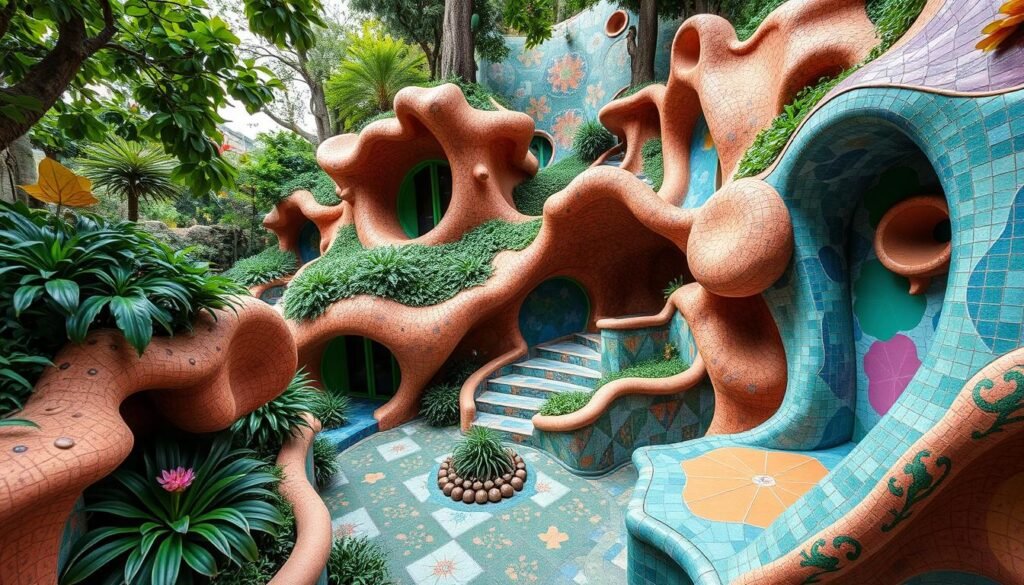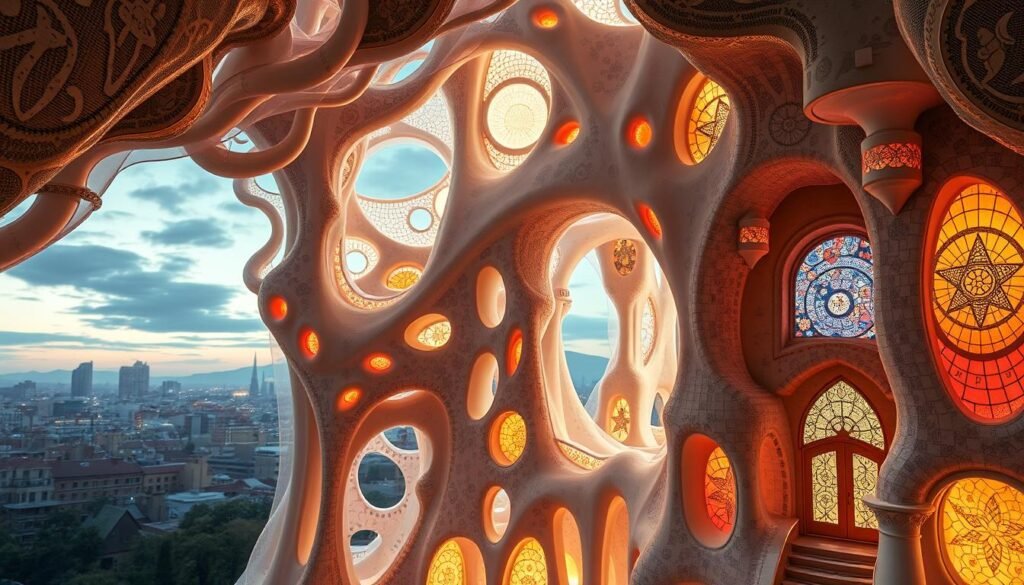Antoni Gaudi’s visionary designs have transformed Barcelona’s architecture. His unique style blends nature and imagination in every curve and line. Gaudi’s art and its hidden inspirations continue to amaze visitors worldwide.
Gaudi’s work goes beyond traditional architectural limits. His buildings seem alive, using organic forms and natural elements in novel ways. The Sagrada Familia, Park Guell, and Casa Batllo showcase his genius.
Gaudi’s creations reveal unseen links to the natural world. The wavy facades of La Pedrera show this connection. The tree-like columns of the Sagrada Familia also display this influence.
His art invites us to look deeper. It helps us appreciate the hidden beauty around us. Gaudi’s work encourages us to see beyond the surface.
Key Takeaways
- Gaudi’s architecture blends nature and imagination
- His designs reveal hidden inspirations and unseen forces
- Organic forms are a key feature of Gaudi’s work
- The Sagrada Familia showcases Gaudi’s unique vision
- Barcelona’s landscape is forever changed by Gaudi’s creations
- Gaudi’s art continues to inspire modern architects
Introduction to Antoni Gaudi’s Visionary Architecture
Antoni Gaudi was a pioneering figure in Barcelona architecture. Born in 1852 in Catalonia, Spain, he revolutionized the Spanish Art Nouveau movement. His unique approach to Catalan Modernism left an indelible mark on Barcelona’s skyline.
The Catalan Modernist Movement
Catalan Modernism thrived in Barcelona during the late 19th and early 20th centuries. It blended traditional Catalan elements with innovative design techniques. Gaudi’s work exemplified this fusion, incorporating vibrant colors and organic forms.
Gaudi’s Unique Artistic Vision
Gaudi’s architectural style was original and bold. His use of parabolic arches provided both structural stability and aesthetic appeal. He innovatively applied ‘trencadís’ – colorful ceramic pieces – adding a distinctive touch to his creations.
The Blend of Nature and Architecture
Gaudi seamlessly integrated natural elements into architectural design. His structures often mimicked organic forms, blending the built environment with nature. This approach is evident in Casa Batlló, where the façade resembles an underwater scene.
“Architecture is the ordering of light; sculpture is the ordering of shadow.” – Antoni Gaudi
Gaudi’s visionary approach continues to inspire architects and artists worldwide. His blend of nature, religion, and innovative techniques created an unparalleled legacy. His work remains a cornerstone of Catalan Modernism and Barcelona architecture.
The Sagrada Familia: A Monument to the Unseen
The Sagrada Familia showcases Antoni Gaudí’s visionary barcelona architecture. This church’s construction began in 1883 under Gaudí’s direction. Despite his death in 1926, the project continues, attracting millions of visitors yearly.
Gaudí designed three striking facades for the Sagrada Familia. Two are complete: the Nativity and Passion facades. The Glory facade’s work started in 2002.
The church will have 18 spires representing religious figures. Currently, eight spires grace Barcelona’s skyline.
Inside, the Sagrada Familia is stunning. Soaring ceilings and pillars create a forest-like atmosphere. Colorful stained-glass windows paint the interior with vibrant hues.
The altar, crowned by a suspended cross, is the heart of this sacred space. Despite ongoing work, the church welcomes about 2.8 million visitors annually.
The rooftop offers amazing views of Barcelona. It showcases Gaudí’s signature tiled finishes, similar to Park Guell and Casa Batlló.
“Architecture is the ordering of light; sculpture is the ordering of shadow.” – Antoni Gaudí
The Sagrada Familia’s completion is set for 2026, marking 100 years since Gaudí’s death. Some estimates extend into the 2040s.
This masterpiece of barcelona architecture remains a living monument. It honors Gaudí’s innovative spirit and the power of faith and creativity.
Park Guell: Nature’s Hidden Influence
Park Guell showcases Antoni Gaudi’s brilliance in Barcelona architecture. It displays Gaudi’s art and nature’s invisible forces that inspired him. Once a luxury housing project, it now enchants visitors with organic forms.
Organic Forms and Natural Elements
Gaudi’s vision blends seamlessly with the landscape. The park boasts winding paths, curved benches, and structures mimicking natural shapes. Vibrant mosaics adorn surfaces, echoing nature’s colorful palette.

Symbolism in Park Guell’s Design
Hidden symbolism enriches the park’s design. Gaudi wove religious and mythological references throughout. The famous “El Drac” salamander statue serves as a fountain and Catalan identity symbol.
The Invisible Harmony of Landscape and Architecture
Park Guell shows Gaudi’s skill in merging architecture with nature. Structures appear to grow from the hillside, creating harmony with the environment. This fusion reveals Gaudi’s aim to make the invisible visible.
| Feature | Description | Significance |
|---|---|---|
| Winding Paths | Curved walkways throughout the park | Mimics natural landscape flow |
| Mosaic Bench | Colorful, serpentine seating area | Represents the sea and nature’s curves |
| Columns | Tree-like supporting structures | Blends architecture with natural forms |
| El Drac | Mosaic salamander fountain | Symbol of Catalan identity and mythology |
Casa Batllo: Unveiling the Oceanic Inspirations
Casa Batllo showcases Antoni Gaudi’s brilliance in Barcelona architecture. This Spanish Art Nouveau gem started as a renovation of an 1877 building. Gaudi transformed it into a stunning artwork that captures the sea’s essence.
Casa Batllo’s facade resembles a calm sea with gentle waves. Its curved balconies rest on stone bases shaped like seashells. Colorful mosaic tiles create a mesmerizing effect, mimicking shimmering water.
The marine theme extends inside the building. The entrance hall boasts a wooden railing like a whale’s backbone. Clever window designs allow natural light to flood every corner.
Gaudi’s innovative ventilation system ensures comfort throughout Casa Batllo. His attention to detail is evident in every aspect of the building’s design.
| Feature | Inspiration |
|---|---|
| Undulating facade | Ocean waves |
| Shell-shaped balconies | Sea creatures |
| Colorful roof tiles | Dragon’s back |
The roof of Casa Batllo is a spectacular sight. Its ceramic tiles form a colorful mantle resembling a dragon’s back. This design ties into the Legend of Saint George, adding symbolic depth.
Casa Batllo is now a UNESCO World Heritage site. It offers an immersive journey into Gaudi’s visionary world. Here, Barcelona architecture blends seamlessly with nature’s wonders.
La Pedrera: The Invisible Forces of Nature
La Pedrera showcases Antoni Gaudi’s architectural genius in Barcelona. Built from 1906 to 1912, it captures nature’s hidden forces. This iconic structure embodies Gaudi’s fascination with natural elements.
Undulating Facades and Invisible Wind
La Pedrera’s wavy facade mimics ocean waves, creating a sense of movement. The building’s 32 wrought iron balconies seem to dance with the wind. This design captures nature’s invisible energy in stone.
Rooftop Warriors: Guardians of the Unseen
Unique sculptural elements adorn La Pedrera’s rooftop. These warrior-like figures twist and turn, shaped by unseen forces. Visitors can explore this otherworldly landscape for 22 Euros, including an audio guide.
The Hidden Structural Innovations
La Pedrera hides groundbreaking structural innovations beneath its artistic exterior. Gaudi’s catenary arches and lightweight materials allowed for open floor plans. This was rare in early 20th-century architecture.
La Pedrera blends art and engineering, making it a marvel of Barcelona’s architecture. As Gaudi’s last major completed building, it inspires architects and visitors alike.
Gaudi Art and the Invisible: Unveiling the Unseen
Antoni Gaudi’s art reveals hidden wonders in Barcelona’s architecture. His catalan modernism style invites viewers to explore unseen dimensions. Gaudi’s creations transform the city into a canvas of invisible beauty.

Casa Batllo showcases Gaudi’s talent for blending nature and architecture. Its wavy facade and organic shapes evoke emotions and spark thought. These features resemble modern data-driven art installations.
Gaudi’s use of materials was groundbreaking for his time. He combined various elements to create unique textures and patterns. His choices revealed hidden inspirations from nature and spirituality.
- Stone
- Ceramic
- Tile
- Wrought-iron
- Glass
- Brick
- Broken tiles from ceramic factories
Gaudi’s works often include subtle symbolism. This invites viewers to look beyond the surface. His creations encourage deeper exploration and reflection.
“Architecture is the ordering of light; sculpture is the play of light.” – Antoni Gaudi
Gaudi’s influence continues to inspire modern architects. His innovative use of space and light remains relevant today. Many contemporary designs draw from his unique approach to architecture.
| Feature | Gaudi’s Art | Modern Installation |
|---|---|---|
| Scale | Entire buildings | Half-mile walkway |
| Materials | Stone, ceramic, glass | Embossed concrete pavers |
| Quantity | Varied by project | 5,000 pieces |
| Inspiration | Nature, spirituality | Microscopic organisms |
Gaudi’s art continues to amaze people worldwide. It reveals the invisible through tangible forms. His work inspires new generations to push architectural boundaries.
The Church of Colònia Güell: Experimental Grounds for the Invisible
The Church of Colònia Güell showcases Antoni Gaudi’s innovative barcelona architecture. This unfinished masterpiece pushed design boundaries. Located near Barcelona, it displays Gaudi’s unique approach to spiritual spaces.
Gaudi’s experimental techniques shine in the church’s crypt. He used catenary arches to distribute weight evenly. This created a space that feels grounded yet ethereal.
The church blends visible and invisible elements seamlessly. Its organic shapes and details evoke spirituality through architecture. Though incomplete, it offers a glimpse of Gaudi’s ambitious plans.
“Gaudi’s work on the Nativity façade and Crypt of La Sagrada Familia” is listed as a UNESCO World Heritage Site, highlighting the enduring impact of his designs.
Visitors can explore Gaudi’s innovative use of materials and forms. The crypt’s slanted columns showcase his mathematical design approach. These elements support the structure and create a sense of movement.
The church influenced Gaudi’s later works, especially the Sagrada Familia. Many techniques developed here appear in his magnum opus. This cements Gaudi’s status as an architectural genius.
Gaudi’s Legacy: Inspiring Modern Architecture
Antoni Gaudi’s vision shapes Barcelona’s architecture and inspires architects worldwide. His unique blend of Spanish Art Nouveau and nature-inspired forms leaves a lasting impact on design.
Influence on Contemporary Architects
Gaudi’s art and invisible elements captivate modern designers. His innovative approach to form and function inspires architects to explore new possibilities.
Designers push boundaries in their work, influenced by Gaudi’s creative genius.
Preserving Gaudi’s Invisible Inspirations
Efforts to preserve Gaudi’s masterpieces ensure future generations can experience his magical creations. The Sagrada Familia’s ongoing restoration showcases the enduring appeal of Gaudi’s work.
The Ongoing Restoration of Gaudi’s Works
Restoration projects across Barcelona maintain the integrity of Gaudi’s designs. These efforts focus on preserving intricate details and hidden symbolism.
Adapting Gaudi’s works for modern use while retaining their unique character is a key goal.
| Gaudi’s Work | Year Started | Current Status |
|---|---|---|
| Sagrada Familia | 1883 | Over 70% complete |
| Park Güell | 1900 | Fully restored |
| Casa Batlló | 1904 | Open to visitors |
Gaudi’s legacy lives on through his timeless creations. His unique approach to Barcelona architecture continues to inspire creativity.
Generations to come will marvel at Gaudi’s Spanish Art Nouveau masterpieces.
Conclusion
Antoni Gaudí’s vision in Barcelona architecture captivates millions yearly. The Sagrada Família, his masterpiece, blends visible and invisible elements. This marvel, under construction for 133 years, will be finished in 2026.
Gaudí’s art intertwines with the unseen through organic forms and natural elements. The Sagrada Família will boast 18 towers and reach 564 feet high. It will become Europe’s tallest religious structure.
Park Güell and Casa Batlló showcase Gaudí’s unique nature-architecture fusion. His work draws about three million visitors to the Sagrada Família annually. Gaudí’s use of the golden ratio and 3D modeling has inspired many architects.
Gaudí’s legacy reminds us of imagination’s power and nature’s hidden beauty. His innovative approach continues to shape architectural thinking today.


